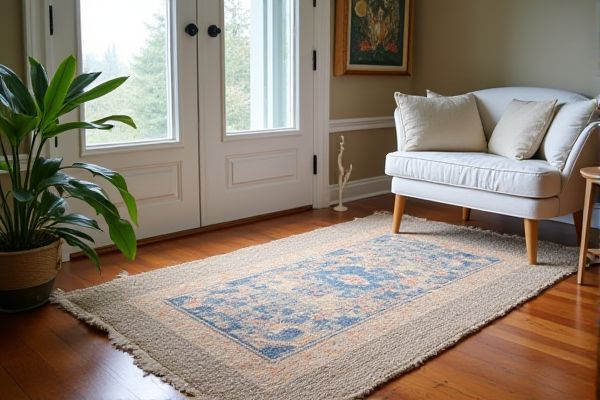
Printed runners offer vibrant designs with intricate patterns easily achieved through modern printing techniques, while woven runners provide durability and texture created by interlacing threads for a more tactile experience. Discover which runner best suits your style and needs by reading the rest of the article.
Table of Comparison
| Feature | Printed Runner | Woven Runner |
|---|---|---|
| Material | Polyester, Cotton blends | Wool, Cotton, Synthetic fibers |
| Design | Digitally printed patterns, vibrant colors | Intricate woven patterns, textured |
| Durability | Moderate, prone to fading | High, long-lasting with wear resistance |
| Texture | Smooth surface | Textured, dimensional feel |
| Maintenance | Easy to clean, machine washable | Requires gentle cleaning, professional care preferred |
| Cost | Affordable, mass-produced | Higher price, artisanal craftsmanship |
| Use Cases | Casual, modern decor | Traditional, elegant decor |
Introduction: Printed vs Woven Runners
Printed runners showcase vibrant designs with detailed color variations, ideal for customization and quick production. Woven runners offer durability and texture through intricate thread work, enhancing elegance and longevity. Your choice depends on whether you prioritize bold visuals or a refined tactile experience.
Material Composition and Durability
Printed runners are typically made from synthetic fabrics like polyester, which allow vibrant designs and colors through advanced printing techniques but may be less durable over time, prone to fading and wear. Woven runners consist of tightly interlaced natural fibers such as cotton, wool, or blends, providing superior durability, texture, and resistance to fraying, making them ideal for high-traffic areas. The material composition of woven runners supports longevity and maintains aesthetic appeal longer compared to the synthetic, print-reliant surface of printed runners.
Design Flexibility and Customization
Printed runners offer superior design flexibility and customization with the ability to reproduce intricate patterns, vibrant colors, and detailed images directly onto fabric. Woven runners, while providing a rich texture and durability, are limited by the weaving process and often have constrained color palettes and pattern complexity. Your choice depends on whether you prioritize detailed visual designs or textured craftsmanship for your runner.
Manufacturing Process Differences
Printed runners are created by applying ink or dye directly onto fabric surfaces using methods like screen printing or digital printing, allowing vibrant designs with intricate color variations. Woven runners are produced by interlacing threads on a loom, integrating patterns into the fabric structure itself for durability and texture. Your choice depends on whether you prioritize detailed graphics with a smooth finish or a textured, long-lasting design.
Visual Appeal and Texture
Printed runners offer vibrant, detailed patterns with smooth textures ideal for showcasing intricate designs and bold colors. Woven runners provide a tactile, textured surface with raised patterns that add depth and a handcrafted aesthetic to any table setting. The choice between printed and woven runners hinges on the desired visual impact and the tactile experience for users.
Cost Comparison: Printed vs Woven
Printed runners generally offer a more cost-effective solution due to lower production expenses and faster turnaround times compared to woven runners. Woven runners involve intricate craftsmanship and durable thread work, resulting in higher material and labor costs, which increase the overall price. Businesses aiming for budget-friendly customization typically prefer printed runners, while those prioritizing longevity and texture opt for the costlier woven option.
Suitability for Different Event Types
Printed runners offer vibrant, customizable designs ideal for casual or themed events where bold visuals enhance the atmosphere. Woven runners provide a more elegant and durable option, perfect for formal occasions or events requiring a sophisticated, textured appearance. Choosing your runner depends on the event's tone, with printed styles suited to lively celebrations and woven styles enhancing upscale gatherings.
Maintenance and Cleaning Requirements
Printed runners require gentle cleaning to preserve the ink quality, often needing spot cleaning with mild detergent and avoiding harsh scrubbing to prevent color fading. Woven runners offer greater durability and ease of maintenance, as they can typically be vacuumed regularly and cleaned with gentle upholstery cleaners without risking damage to the fibers. Your choice should consider how much cleaning effort you are willing to commit, with woven runners generally providing more resilient and low-maintenance options.
Eco-Friendliness and Sustainability
Printed runners generally use fewer resources and chemicals during production compared to woven runners, making them a more eco-friendly choice. Woven runners often require more energy-intensive processes and synthetic fibers, which can impact sustainability negatively. Choosing your runner with natural fibers and low-impact dyes supports environmentally conscious home decor.
How to Choose the Right Runner for Your Needs
Printed runners offer vibrant designs and customization options ideal for seasonal or themed decor, while woven runners provide durable texture and classic patterns suited for everyday use. Consider the setting: printed runners enhance aesthetic appeal in formal or temporary settings, whereas woven runners endure higher foot traffic and frequent washing. Evaluate material durability, design preference, and intended use to select the runner that best balances style and functionality.
 homyna.com
homyna.com